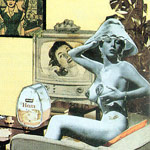Pop Art

The beginning of Pop Art as an artistic movement is often pegged to Richard Hamilton’s 1956 collage Just What Is It that Makes Today’s Home’s So Different, So Appealing? and that’s where we start our class today. We also look at our local fathers of Pop, Jasper Johns and Robert Rauschenberg. Both of these artists, whose careers began in New York in the 1950s, show us a style of work that breaks with many of the basic premises of Abstract Expressionism. Yet they also exhibit a quality of painterly expression, which betrays acknowledgement of the prevalent style of the time.
So, what was it that makes these artists so different, so appealing? With a little background into the Black Mountain College, and the work of John Cage, we take a peak onto the world of performance, and happenings, and how this work opened up possibilities for artists such as Rauschenberg and Johns. Possibilities which fit outside of the formalist, non-representational work that was receiving most of the attention. Contrary to Greenberg’s wish for each medium to be isolated, we see pieces with representation and narrative, paintings which are also sculptures, sculptures which also serve as backdrops for performance.
Often a distinction arises between the critical nature of British pop art, and the American Pop Art’s unapologetic embrace of consumer culture. But let’s not be too broad in this generalization, as the underlying unease we see in the Abstract Expressionists also shows up in pieces like F-111 by James Rosenquist, which features a young child blissfully having her hair done at a beauty salon, while a mushroom cloud erupts in the background. Or Andy Warhol’s pieces on the Birmingham Race riots, or the car accidents from his disaster series.
After this class you should be able to
Define the following:
- Pop art, and who fits into this category
- Black Mountain College
- Happenings
- encaustic, and who used it
Recognize artwork by the following artists:
- Jasper Johns
- Richard Hamilton
- David Hockney
- Alex Katz
- Roy Lichtenstein
- Claes Oldenburg
- Robert Rauschenberg
- James Rosenquist
- Wayne Thiebaud
- Andy Warhol
- Tom Wesselmann
Answer the following:
- Who was John Cage, and what was his piece 4’33”?
- How did performance art influence the work of artists such as Robert Rauschenberg and Claes Oldenburg?
- How do Pop artists continue Abstract Expressionism’s use of scale?
- Why does Andy Warhol say he wants to be a machine?
External Links for further reading:
- MOMA’s 1997 show of Jasper Johns
- A close look at Jasper John’s Perilous Night
- Claes Oldenburg website
- Claes Oldenburg interview
- David Hockney Website
- Alex Katz interview
- Andy Warhol – The Elvis Works
